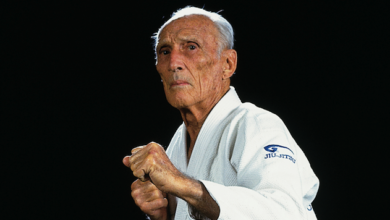Mitsuyo Maeda: The Man Who Brought Jiu-Jitsu to Brazil

Experts: Mitsuyo Maeda (前田 光世, Maeda Mitsuyo), also known as “Conde Koma” (The Count of Combat), was born on November 18, 1878, in Funazawa Village, Hirosaki, Aomori Prefecture, Japan. He grew up during the Meiji Restoration, a period of modernization and transformation in Japan.
As a child, Maeda was physically small and frail, but he developed a strong interest in martial arts. His fascination with combat and physical training eventually led him to study Judo, which was emerging as a revolutionary martial art under Jigoro Kano.
Introduction to Judo and Kodokan Training

In 1895, at the age of 17, Maeda moved to Tokyo to further his education and pursue martial arts training. He became a student at the Kodokan Judo Academy, the institution founded by Jigoro Kano, the creator of modern Judo.
Under the instruction of Sakujiro Yokoyama and Tsunejiro Tomita, two of Kano’s top students, Maeda quickly gained recognition for his skill, technical understanding, and relentless fighting spirit. Despite his small stature (standing about 5’5” (165 cm) and weighing around 154 lbs (70 kg)), he demonstrated exceptional grappling abilities and an ability to defeat larger opponents using leverage, throws, and ground control.
By the early 1900s, Maeda had earned a high rank in Judo and became one of Kodokan’s top fighters, specializing in ground fighting (ne-waza) and submission techniques.
The Global Judo Ambassador: Maeda’s Travels
Jigoro Kano envisioned Judo as a universal martial art and sent his top students abroad to promote it worldwide. In 1904, Maeda was selected as part of this mission and began his international journey, demonstrating Judo across multiple continents.
United States (1904 – 1908)
- Maeda arrived in New York in 1904, alongside Tsunejiro Tomita.
- They performed Judo demonstrations at prestigious institutions like Columbia University.
- While Tomita focused on theory and philosophy, Maeda engaged in practical combat.
- He faced boxers, wrestlers, and catch wrestlers, proving Judo’s effectiveness in real fights.
- After Tomita returned to Japan, Maeda continued to fight and teach throughout the U.S.
Europe and Cuba (1908 – 1914)
- Maeda traveled to London, Spain, and Portugal, competing against European wrestlers.
- He gained a reputation as an unbeatable fighter, earning the nickname “Conde Koma” (The Count of Combat).
- In Cuba, he participated in no-holds-barred challenge matches, further proving the power of Judo and Jiu-Jitsu.
Arrival in Brazil (1914)
In 1914, Maeda settled in Brazil, where he demonstrated Judo to the Brazilian elite. He was instrumental in establishing a Japanese colony in Brazil and received support from Gaston Gracie, a wealthy Brazilian businessman.
The Birth of Brazilian Jiu-Jitsu: Teaching Carlos Gracie
While in Belém do Pará, Brazil, Maeda began teaching Judo and Jiu-Jitsu to local students. Among them was Carlos Gracie, who would later become the founder of Brazilian Jiu-Jitsu (BJJ).
Carlos absorbed Maeda’s teachings and, along with his younger brother Hélio Gracie, adapted the techniques to create a ground-based grappling system, emphasizing:
✔ Leverage over strength – Allowing smaller fighters to defeat larger opponents.
✔ Ground fighting dominance – Submissions, chokes, and positional control.
✔ Efficiency and adaptability – Practical combat techniques for real-life scenarios.
This evolution laid the foundation for modern BJJ, one of the most effective martial arts in the world today.
Maeda’s Fighting Career and Challenge Matches
Mitsuyo Maeda was a true warrior, engaging in over 1,000 fights throughout his career. His challenge matches included:
✔ Victories against boxers, wrestlers, and street fighters.
✔ Defeating much larger opponents using superior technique.
✔ Fighting under various rulesets, including no-holds-barred fights.
He proved that grappling was superior to striking in real combat, influencing the rise of submission fighting and modern MMA.
Later Years and Death
In his later years, Maeda continued to teach Judo and influence combat sports in Brazil. He settled in Belém, where he trained many Brazilian fighters who carried on his teachings.
Maeda passed away on November 28, 1941, at the age of 63, but his legacy in martial arts would last forever.
The Legacy of Mitsuyo Maeda
1. The Father of Brazilian Jiu-Jitsu
Mitsuyo Maeda’s teachings led to the creation of Brazilian Jiu-Jitsu, which is now practiced by millions worldwide. Without his influence, the UFC, MMA, and modern submission grappling might not exist.
2. Proving Grappling in Real Combat
Maeda demonstrated that ground fighting and submissions were the key to overcoming larger opponents, inspiring future martial artists.
3. One of the Greatest Martial Artists in History
With over 1,000 fights, Maeda ranks among the most accomplished and experienced fighters of all time.
4. Global Expansion of Judo and Jiu-Jitsu
His world tours and demonstrations helped spread Judo and Jiu-Jitsu across multiple continents, influencing the development of martial arts worldwide.
Mitsuyo Maeda’s Influence on Modern MMA and BJJ
✔ Gracie Jiu-Jitsu and BJJ – His teachings directly influenced Carlos and Hélio Gracie, leading to the formation of Brazilian Jiu-Jitsu.
✔ UFC and Mixed Martial Arts (MMA) – Royce Gracie’s dominance in early UFC events showcased the power of Maeda’s grappling techniques.
✔ Submission Grappling and No-Gi Fighting – Maeda’s emphasis on ground control and submissions became a cornerstone of modern grappling competitions.
The Immortal Legacy of Mitsuyo Maeda
Mitsuyo Maeda was more than a Judo master—he was a pioneer, fighter, and innovator who changed the course of martial arts history. Without his influence, the world might never have witnessed the birth of Brazilian Jiu-Jitsu, the dominance of grappling in MMA, or the explosion of combat sports worldwide.
His name remains legendary, ensuring that he will forever be known as “The Man Who Brought Jiu-Jitsu to Brazil”.



